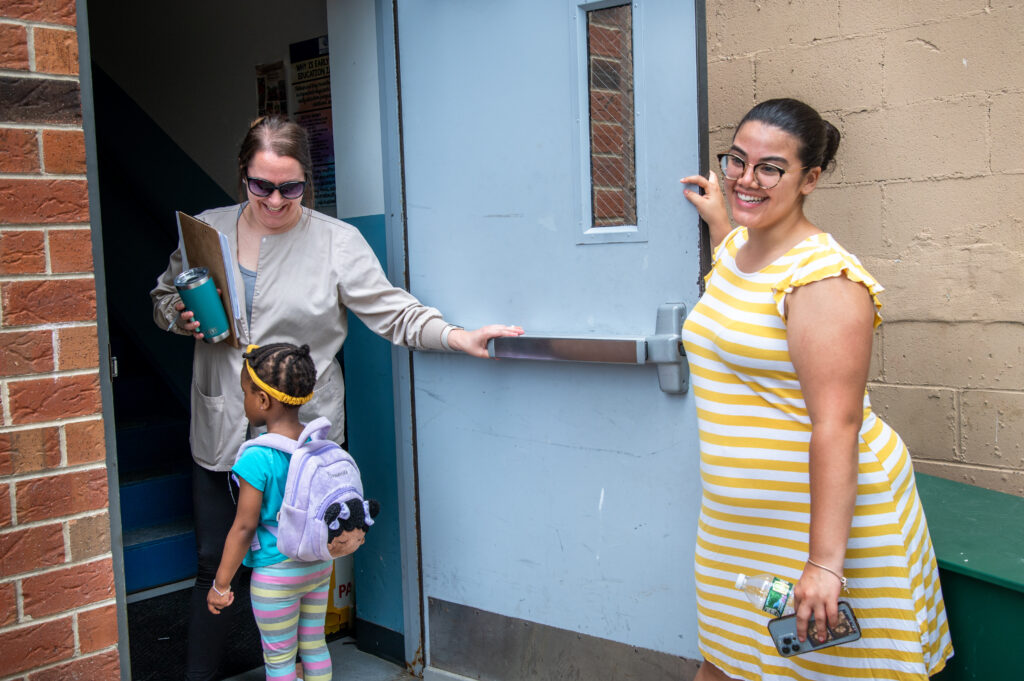Public Funding
What Is Public Funding?
Public funding is federal, state, and local investment in the early care and education workforce and the broader ECE system.
To realize the vision of an early care and education (ECE) system in which all early educators are well compensated and supported to thrive requires a nationwide overhaul of the ECE system and vastly increased public investment.1 Gould, E., & Blair, H. (2020). Who’s Paying Now? The Explicit and Implicit Costs of the Current Early Care and Education System. Center for the Study of Child Care Employment, University of California, Berkeley. https://cscce.berkeley.edu/publications/report/whos-paying-now-the-explicit-and-implicit-costs-of-the-current-early-care-and-education-system/. The current system overburdens parents financially, yet still underfunds programs and educators. Imagine if parents had to individually shoulder the cost of third grade for their child or if elementary school teachers’ wages were determined by what parents could afford.
The needs of the ECE workforce were prioritized in unprecedented ways in the context of the COVID-19 pandemic. For example, programs received operational grants to cover personnel costs, including wages and benefits (see States’ Use of Pandemic Relief Funding). This historic influx of flexible federal funding allowed state and program leaders to support the sector following the severe economic and psychological shocks of the pandemic. This funding also provided federal and state policymakers an opportunity to reimagine how early care and education is funded, both in the short and long term.
As these critical funds expire, simply restoring the pre-pandemic system is not the answer to the decades-long child care crisis. A transformative vision and public funding to implement that vision are critical to building a system that delivers on the promise of early education for all children, their families, and the educators they rely on. Many effective tools were tested during the pandemic, including the use of grants and contracts, as well as payments to providers based on enrollment rather than attendance. Both strategies are crucial to providing stable funding to ECE programs and are now part of official child care subsidy regulations.2 Ferrette, T., Girouard, D., Estlund, M., Wilensky, R., Saxena, A., & Schulman, K. (2024). The Child Care and Development Fund 2024 Rule: Detailed Summary and State Examples. The Center for Law and Social Policy. https://www.clasp.org/wp-content/uploads/2024/05/2024_CCDF-2024-Rule-Detailed-Summary-and-State-Examples.pdf.
The time is past due to overcome sticker shock about the costs of an effective and equitable ECE system that is appropriately funded. Federal programs like the Child Care Development Fund (CCDF), Head Start, and Preschool Development Grants Birth-Five (PDG B-5) continue to be important sources of funding for early care and education. Nevertheless, state policymakers have considerable leeway—and therefore, the responsibility—to prioritize early care and education in their own state budgets. It is imperative that states articulate how the long-term funding vision outlined in the National Academies’ Transforming the Financing of Early Care and Education3 National Academies of Sciences, Engineering, and Medicine (NASEM). (2018). Transforming the Financing of Early Care and Education. The National Academies Press. https://doi.org/10.17226/24984. can be applied in their state context to determine the level of national and state resources required to implement this vision.
“…State policymakers have considerable leeway—and therefore, the responsibility—to prioritize early care and education in their own state budgets.”
Vermont Raises State Revenue for ECE Via Payroll Tax
Act 73, a historic child care bill for Vermont and the country, was passed into law in 2023.1Vermont Department of Children and Families. (2023). Act 76 (H. 217). https://dcf.vermont.gov/cdd/laws-rules/h.217. The legislation enacted a new payroll tax to build a Child Care Contribution Special Fund that ensures sustained new investment in early care and education, including increased subsidies for programs and expanded eligibility for families. It follows 2021 legislation that mandated a financing study to understand the funding needed for significant reform of the ECE system, including ensuring that early educators receive compensation that is “commensurate with peers in other fields.”2Vermont General Assembly. (2023). No. 45. An Act Relating to Child Care Systems and Financing (H. 171). https://legislature.vermont.gov/Documents/2022/Docs/ACTS/ACT045/ACT045%20As%20Enacted.pdf; Karoly, L.A., Strong, A., & Doss, C.J. (2023). Vermont Early Care and Education Financing Study: Estimated Costs, Financing Options, and Economic Impacts. RAND. https://www.rand.org/pubs/research_reports/RRA2213-1.html. While efforts to formalize minimum pay standards for early childhood educators in Vermont continue,3Vermont Association for the Education of Young Children. (n.d.). Project Leadership. https://www.vtaeyc.org/project-leadership/. achieving a sustainable, dedicated state revenue source is a key step toward that vision.

A crucial step in determining the funding needed for early care and education is for states to engage in cost-modeling and the development of a multiyear plan for implementation. Many states now have their own cost models and/or cost studies that can be used in advocacy, planning, and child care subsidy rate setting.4 Children’s Funding Project. (n.d.). Cost Model Resources. https://static1.squarespace.com/static/5b75d96ccc8fedfce4d3c5a8/t/601825b5a4dbda565b319f21/1612195253684/Cost+Model+Resources_CFP.pdf; Prenatal to Five Fiscal Strategies. (2023). Fiscal Modeling Studies. https://www.prenatal5fiscal.org/fiscal-modeling. States that don’t already have a cost model can use 50-state resources, like P-5 Fiscal Strategies’ 50-State Cost Model,5 Prenatal to Five Fiscal Strategies. (2023). 50-State Child Care Cost Model. https://www.prenatal5fiscal.org/childcarecostmodel. to understand how different staffing and salary criteria affect the overall cost of providing ECE services. It is critical that such cost models reflect appropriate conditions for the workforce.6 Center for the Study of Child Care Employment. (2019). The Model Work Standards. https://cscce.berkeley.edu/publications/report/creating-better-child-care-jobs-model-work-standards/. Such conditions include supporting educators to achieve entry-level and advanced qualifications, work environments that facilitate effective teacher practice and protect their well-being, and appropriate increases in compensation that are sufficient to attract and retain skilled educators.7 Austin, L.J.E., Whitebook, M., & Dichter, H. (2019). Financing Early Educator Teacher Quality: A Closer Look at Assumptions That Drive Variations in Estimating the Cost of Services. Center for the Study of Child Care Employment, University of California, Berkeley. https://cscce.berkeley.edu/files/2019/07/CSCCE-Financing-EarlyEducator-Quality.pdf. State-by-state estimates developed by CSCCE and the Economic Policy Institute are a good starting point to understand likely costs at the state level (see Appendix Table 3.12).
Simultaneously, there are existing opportunities for states to devote additional funding to early care and education as a down payment toward the level of funding that will ultimately be required. State-funded pre-K has been a primary means of dedicated state ECE spending over the past several decades,8 Friedman-Krauss, A.H., Barnett, W.S., Garver, K.A., Hodges, K.S., Weisenfeld, G.G., & Gardiner, B.A. (2020). The State of Preschool 2019. National Institute for Early Education Research. http://nieer.org/state-preschool-yearbooks/2019-2. but states can also contribute resources in other ways, such as additional spending on child care services.
Future editions of the Index may include additional or new state efforts to move toward a publicly funded system of early care and education for all children birth to five, such as Vermont’s payroll tax or New Mexico’s Early Childhood Education and Care Fund.9 New Mexico Early Childhood Education and Care Department. (2024, February 16). New Mexico Continues to Lead the Nation in Early Childhood Investment. https://www.nmececd.org/2024/02/16/new-mexico-continues-to-lead-the-nation-in-early-childhood-investment/. In the meantime, the 2024 Index continues to assess whether states are, at a minimum, devoting additional state funding above and beyond what is required to receive federal funding for early care and education.
“Public funding is so important to get any of the other things we’re talking about. We need the money first. Focus on public funding that ties the good of child care to what it does for society in order to get that public investment.”

What Can Be Done: Policy Opportunities for Change
Identify the public funding needed to attract and retain qualified early educators and ensure equitable ECE access for all children and families.
- Stop using market-based approaches to child care (i.e., prices determined by what families can afford to pay). Instead, use a Cost Estimation Model4Capito, J., & Workman, S. (2021). Using cost estimation to inform child care policy: How to develop a cost estimation model that reflects the cost of care and the true needs of the child care system. Prenatal to Five Fiscal Strategies. https://www.prenatal5fiscal.org/_files/ugd/8fd549_62d3a75d3ede423abebc6b1841e8c328.pdf. to gauge the true costs of advancing workforce preparation, increasing workforce compensation supported by a salary scale, and improving working conditions, while also relieving the financial burden on families.
- Through a Cost Estimation Model, states can identify the additional public funding required to close the gap between existing public funds and the true costs to accomplish necessary reforms. To understand the landscape of existing public funds, consider creating a fiscal map.5Children’s Funding Project. (n.d.). Fiscal Mapping. https://childrensfundingproject.org/our-work/fiscal-mapping/
- At a minimum, working within the subsidy system, states can switch to an alternate methodology for determining CCDF rates (as per Housing and Human Services recommendations) that includes accurate cost estimates6Gould, E., Whitebook, M., Mokhiber, Z., & Austin, L.J.E. (2020). Financing Early Educator Quality, A Values-Based Budget for Every State. Center for the Study of Child Care Employment. University of California, Berkeley. https://cscce.berkeley.edu/publications/report/financing-early-educator-quality-a-values-based-budget-for-every-state/. to increase compensation and retain a high-quality workforce. However, subsidy reimbursement is just one funding mechanism and does not reach all child care programs.
Commit to securing dedicated, sustainable funds to realize comprehensive reforms.
- Policymakers can prioritize early care and education in state budgets in addition to (or in the absence of) increased federal funding.
- Advocates can launch campaigns to inform policymakers and help educate the public about the costs of building an equitable system and the benefits of this investment as a public good.7Lawrence, B.J., & Sharrock, E. (2021). Establishing Early Care & Education as a Public Good. Bank Street College of Education. https://educate.bankstreet.edu/cgi/viewcontent.cgi?article=1007&context=bsec
- Engage voters to activate reforms by proposing ballot measures that set up dedicated sources of revenue8Louisiana Policy Institute for Children. (2019). Prioritizing Our Future: How cities and state dedicate funds for early care and education. https://static1.squarespace.com/static/5b75d96ccc8fedfce4d3c5a8/t/609d6bd632bdfc6bf78c5bb0/1620929496155/LPIC%2BFinal%2Bpaper.pdf. to fund early care and education locally and throughout the state.
- Use data as evidence to show that the additional public funding made available through pandemic relief funds helped stabilize the ECE system and workforce.
Design and activate a phased implementation plan to equitably allocate new and existing funds to establish an ECE system that operates as a public good.
- Build in annual fund adjustments to adjust for inflation, cost of living increases, and changes to regulations (e.g., minimum wage increases) and/or licensing and quality standards.
- Consult providers to ensure that implementation plans are designed to advance equity and remedy existing disparities, while also aligning with the providers’ immediate and long-term needs.
- Partner with providers to develop feedback loops that inform and improve implementation through ongoing engagement, data collection, and analysis.
Explore opportunities to invest directly in ECE programs using grants and contracts, learning from the implementation of American Rescue Plan Act (ARPA) stabilization grants.
State Progress on Public Funding
- Stalled: 20 states
- Edging Forward: 24 states
- Making Headway: 7 states
- Not Available: 0 states
- Not Applicable: 0 states
Overall, there was some progress on public funding across states since the 2020 Index. Fewer than one half of states remain stalled, compared with more than one half in 2020, while seven states are now making headway, compared with only two in 2020 (see Figure 3.5.2). This movement is most likely influenced by pandemic-era funding: 12 additional states reported extra CCDF spending during 2018-2020, compared with previous years, with the majority doing so in 2020 when CARES Act funding became available.
Between 2020 and 2024, 19 states improved their assessment by meeting one or both of the key public funding indicators:
- Six states (California, Maryland, Michigan, New Jersey, North Carolina, West Virginia) improved from edging forward to making headway by meeting both indicators.
- 13 states (Alaska, Delaware, Hawaii, Maine, Massachusetts, Minnesota, Nevada, New Hampshire, New Mexico, New York, Texas, Utah, Virginia) advanced from stalled to edging forward.
However, five states moved down in their assessment:
- Tennessee shifted from making headway to stalled, while Montana, Ohio, Rhode Island, and Vermont moved from edging forward to stalled, no longer meeting either of the public funding indicators.
Table 3.5.1.
Key to State Progress on Public Funding

Figure 3.5.1.
Map of State Progress on Public Funding, 2024
Figure 3.5.2.
Number of States Making Progress on Public Funding, 2020 and 2024
Figure 3.5.3.
Number of States Making Progress on Public Funding Per Indicator, 2020 and 2024
State Progress on Public Funding: Indicators
Indicator 1: Did the state report extra Child Care Development Fund spending?
Rationale: The Child Care Development Fund (CCDF), authorized by the Child Care and Development Block Grant (CCDBG), is a core source of federal funding for ECE services and for initiatives pertaining to the ECE workforce. CCDF funding remains far below what is needed to achieve high-quality ECE services. In order to receive all federal CCDF funds, states must spend a set match amount and meet Maintenance of Effort (MOE) requirements. We focus on whether states spent over and above the minimum requirement for matching or MOE funds for at least one of the preceding three fiscal years for which data are available (2018-2020), using CCDF expenditure data from the Center for Law and Social Policy (CLASP).11 Personal communication with Stephanie Schmit, Alisha Saxena, and Rachel Wilensky, Center for Law and Social Policy, May 2024. Because states are not required to report whether they spend above the minimum required, the totals shown here may be underestimates.
Current Status Across States: A total of 19 states (Alaska, California, Colorado, Georgia, Louisiana, Maine, Maryland, Massachusetts, Michigan, Minnesota, Nebraska, New Hampshire, New Jersey, New Mexico, New York, North Carolina, Texas, Utah, and West Virginia) and the District of Columbia reported extra CCDF spending for early care and education beyond what is required to receive federal funds during at least one year in the 2018-2020 period. Seventeen of these states reported extra CCDF spending in 2020, which was likely influenced by states transferring funds between spending categories and funding streams as a result of the CARES Act.12 U.S. Department of Health and Human Services, Administration for Children and Families. (2022, August 15). CCDF Expenditures Overview for GY 2020 as of 09/30/2020. https://www.acf.hhs.gov/occ/data/ccdf-expenditures-overview-gy-2020-9-30-2020.
Change Over Time: The total number of states that met this criteria increased by 15 states and the District of Columbia since the 2020 Index. Specifically, Alaska, California, Maine, Maryland, Massachusetts, Michigan, Minnesota, New Hampshire, New Jersey, New Mexico, New York, North Carolina, Texas, Utah, and West Virginia reported additional CCDF spending and joined previous states that met this criteria. Ohio, Tennessee, Vermont, and Washington no longer met the criteria because they did not report additional spending for any year during 2018-2020.
Indicator 2: Is pre-K spending per child more than 50 percent of K-12 spending per child?
Rationale: Of all the areas of early care and education, publicly funded pre-K has come the closest to being accepted as education and a public good for all children. Nonetheless, funding per child on pre-K is still lower than funding for older children.
Current Status Across States: Eighteen states spend at least half as much per child on public pre-K compared to per-child spending on public K-12 education. However, in some cases this finding may be due to low spending on K-12 rather than high spending on pre-K: 11 of these 18 states fall below the median per-child spending on K-12 across all states ($17,077).
Change Over Time: Since 2020, there was a net increase of one additional state in which per-child pre-K spending is more than half of K-12 per-child spending.
- Thirteen states maintained a ratio of at least 50-percent pre-K to K-12 per-child spending and continued to meet this criteria for 2024.
- Five states (Delaware, Hawaii, Nevada, Virginia, and Washington) increased their ratio of pre-K funding and now meet the criteria for this indicator in 2020.
- On the other hand, three states (Montana, Rhode Island, and Tennessee) and the District of Columbia dipped below the threshold for this indicator.

Table 3.5.2.
Progress on Public Funding, By State and Territory, 2024
Continue reading →
Next Section: Appendices
